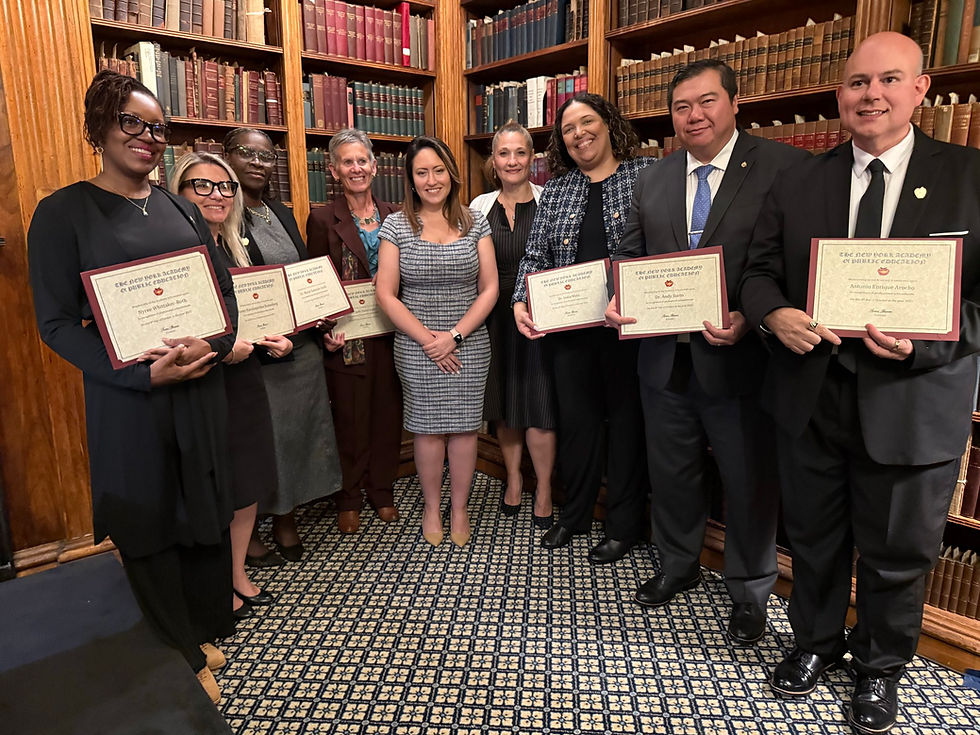Dr. Andy Szeto: The Jacket That Finally Fit
- Walter McKenzie

- Oct 29
- 5 min read
Updated: Nov 30


I still remember the day a teacher caught me off guard by saying, “I have shoes older than you are.” I had just become an assistant principal at 28, eager to prove myself. The comment landed harder than she probably intended. It was meant as small talk, maybe even lighthearted teasing, but it carried a truth I could not ignore. I was young. I looked young. And in a profession where perception often precedes credibility, that was something I felt every day.
I thought about replying that maybe it was time for her to buy new shoes, but decided my first week as an assistant principal was not a moment to test HR policy. So I smiled and walked away. But the remark stayed with me. That afternoon, I stood in front of the mirror in my office. I saw a rookie administrator trying to lead teachers who had been in classrooms longer than I had been in the workforce. My shirt sleeves were slightly too long, my sport jacket a bit boxy, and my tie knot too small. I looked like someone playing the part of “assistant principal” rather than being one.
So I made a decision. If I was going to look the part, I would commit to it.
The Early Years: Dressing for Perception
In those first few years, I poured a surprising amount of energy into what I wore. I tried hard, but it often didn’t work. Some jackets felt like they belonged to someone else. Part of it was that I was buying things on sale because that’s what fit my budget, and part of it was that I wasn’t exactly a sartorial expert. I didn’t know the difference between a good fit and a good deal. I just hoped that if I looked polished enough, people might see me as more capable than I felt.
I walked through hallways, clipboard and walkie-talkie in hand, conscious of how every step looked. When I spoke at staff meetings, I wondered if people were listening to my message or to the fact that I looked too young to deliver it. I was constantly performing, hoping my clothes could do some of the heavy lifting of leadership.
I was growing as an administrator, learning how to lead meetings, navigate tough conversations, and manage the daily chaos that comes with school life. But in those moments, I often felt like I was playing a part, someone older, more confident, and somehow less me.
At the time, I didn’t realize that I was changing more than my wardrobe. I was reshaping my identity around what I thought others expected to see. I believed that authority came from imitation rather than authenticity.
Looking back, I realize what I was feeling had a name: imposter syndrome. I measured my worth against how well I could perform a version of leadership that didn’t quite look like me. In meetings, I would catch myself mirroring the gestures, tone, and wardrobe of others who seemed more official. It wasn’t just about clothes; it was about belonging in spaces that weren’t always built with someone like me in mind. For many young leaders, especially leaders of color, the pressure to appear confident often hides a quiet doubt about whether we are allowed to be here at all.

The Middle Ground: Learning What Fits
Over time, something began to shift. The routines of leadership became more natural. Conversations that once made me nervous became part of the rhythm of my day. I began to understand that people responded less to what I wore and more to how I showed up.
I no longer dressed to close a credibility gap. I dressed to feel prepared and present. I started paying attention to what felt right rather than what appeared right. I traded stiffness for movement, formality for ease. My clothes stopped being armor and started being an extension of how I worked.
Perception can sometimes outrun substance. When leadership opportunities arise, people gravitate toward those who look the part, who project a familiar image of authority. That bias, subtle but persistent, can keep capable voices unseen. For years, I tried to outdress those doubts, not realizing that I was trying to earn legitimacy through optics rather than through authenticity.
Growing Into My Own Style
Years later, I grew into the look I once adopted to seem older. The difference is not what I wear, but how I feel in it. My style now reflects who I am, not who I was trying to be. I buy most of them used, but I look for pieces with classic tailoring, quality fabric, and that polished, timeless fit.
Now, when I wear a vintage Harris Tweed sports jacket to work, it is not to appear older or more refined. It is because I want to. I bought it because I liked it, got it cheap, and it feels right. There is something about putting on that jacket that feels like returning to myself. The texture reminds me of how far I have come, the subtle weight of it grounding me before a busy day. It is no longer about signaling authority; it is about being comfortable in my own skin.
In a field that prides itself on fairness and inclusion, it is encouraging to see how far we have come. There is greater diversity in leadership today than when I first began, and that progress matters. Still, representation continues to shape how leadership is perceived in ways we do not always name. At times, leadership selections still lean toward a more traditional image of what leadership has historically looked like. Recognizing that gap motivates me. Every time I step into a room wearing that jacket, I hope it quietly broadens someone’s idea of what a leader can look like.
I think about that sometimes when I pass younger administrators in the hallway, dressed in their own versions of confidence. I see the effort, the thought behind every detail. I recognize the quiet worry that they might not be taken seriously. I do not have advice to give. I just understand.

Closing Reflection
That comment about “shoes older than you” once made me feel small, like I had to prove I belonged. Now it makes me smile. It reminds me that leadership, like clothing, takes time to fit right. The clothes that once felt like a costume have become a reflection of genuine growth.
In many ways, our profession mirrors that same struggle. Formal titles, evaluations, and optics still carry enormous weight in how we define success. Yet the essence of leadership, the ability to listen, guide, and humanize, rarely fits neatly into a rubric or a dress code. I have learned that growth in leadership is not about mastering appearances but about softening into purpose.
What I choose to wear is part of how I express care for the work, for the people around me, and for myself. It matters, not because clothes make the leader, but because the leader eventually gives the clothes their meaning.
I know authenticity matters. But I also know perception is hard to beat. Maybe that tension is what keeps leadership human.
If the jacket finally fits, it is not because I grew into someone else’s idea of a leader. It is because I grew into my own. And maybe that is the real work for all of us in education: to help the next generation see that leadership does not come pre-tailored.
Lead Forward is an exclusive feature by Dr. Andy Szeto on The Worthy Educator. Check back regularly for new insights for aspiring leaders!







Comments